See this later article published 21 December 2013:
Alfred Bock sent Samuel Clifford an urgent telegram from Port Arthur on 27th March 1866 requesting 24 dry plates – panoramic. Thomas Nevin duly arrived at Port Arthur with a case of photographic glass. The details of the telegram were recorded as -
March 1866 Account of Private Telegrams
Date 27th March, No. 269, Alfred Bock to Mr Clifford Liverpool St. H. Town,
“Send down 24 dry Plates Panoramic. by the Shannon, at once. – Reply.”

Alfred Bock self-portrait ca. 1863
QVMAG Ref: Q1991_P_0006a
In 1863, Thomas J. Nevin applied for an apprenticeship with Alfred Bock at his studio, The City Photographic Establishment, 140 Elizabeth-street, Hobart Town. Alfred Bock's advertisement for "An Apprentice wanted" appeared in The Mercury, 7th July 1863:
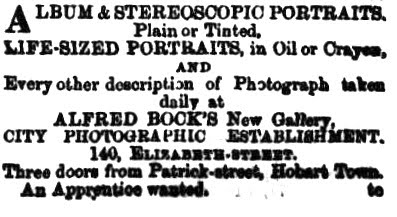
The Mercury, 7 July 1863.
Bock's new gallery was actually a glass house.
By 1864, Alfred Bock and Thomas Nevin were engaged in a dispute with photographer Henry Frith about the origins and rights to the sennotype process, and by 1866, financially bruised by the experience, both Alfred Bock and Henry Firth abruptly departed Tasmania.
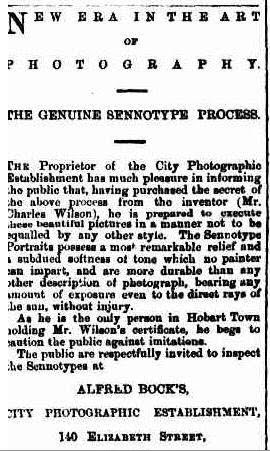
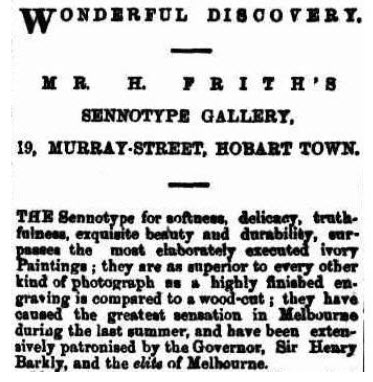
Above:
Alfred Bock's and Henry Frith's advertisements for sennotypes,
The Mercury, 4 March 1864.
Thomas Nevin acquired Bock's studio, equipment and stock of negatives, and carried on the business in his own name until joined briefly by Robert Smith (1865-1868). The partnership with Smith was dissolved in February 1868 by W.R. Giblin, Nevin's solicitor. Nevin continued with commercial photography and procured tenders with help from Giblin for contracts with the Police Office to photograph prisoners. Nevin's early experiences visiting the Port Arthur prison site with Alfred Bock ca. 1865 were the first in a long association with the Police and Prisons Department.

Henry Frith's departure, The Mercury, 16 October 1865
Decades later, this notice appeared in the Tasmanian Mercury, on 22nd May 1900:
PERSONAL: - Mr Alfred Bock, writing from Auburn, Victoria, intimates that he is not dead, neither is he "the late Mr. Bock", as stated in a note under a picture of the late Mr Boyd in a recent copy of "The Tasmanian Mail." He adds:- "I suppose by the 'late Mr. Bock' it means to refer to my father, but he never took a photograph in his life. The picture was actually taken by me on the occasion of my visiting Port Arthur at the request on the officers of the station for the purpose of painting a portrait of Mr Boyd for presentation to that gentleman; I think about 1863 or 1864; I am not quite sure as to the year. I should be glad if you could make the correction, especially as some of my friends have been inquiring about my decease.
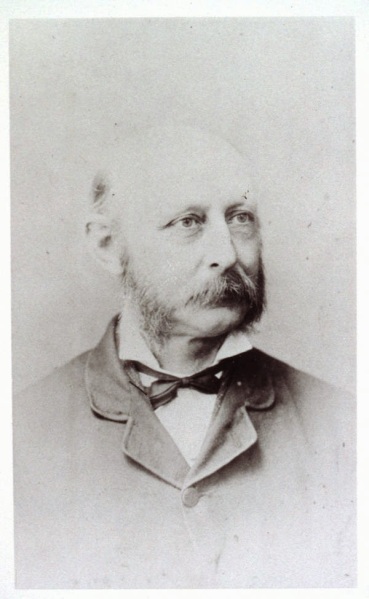
State Library of Tasmania
Title: Alfred Bock c1880
Creator(s): Bartlett, R. H
Date: 1880
Description: 1 photograph : b&w. ; 13 X 8 cm.
Notes: Exact measurements of copy: 129 x 77 mm, Title inscribed in pencil on verso in unknown hand., Head and shoulders inclined to right., B&w copy of sepia cabinet photograph in Bock purchase 1969.
Location: Allport Library and Museum of Fine Arts
ADRI: AUTAS001125882209
Apart from the refutation of the expertise of his father Thomas Bock as a daguerreotypist, this notice is interesting in that it places Alfred Bock at Port Arthur between the dates 1863 and 1866, accompanied by his successor Thomas J. Nevin. The painting in question (below, left) was the official presentation gift, but there were more images than just one by Bock of this particular individual, James Boyd, Commandant of the Port Arthur prison site.
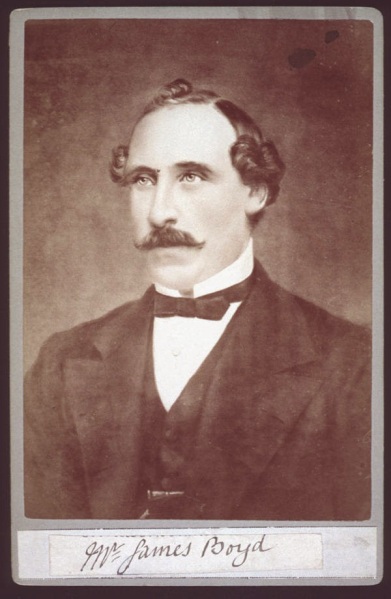

Portraits of James Boyd by Alfred Bock ca 1864 (SLTas)
At left is an example of Alfred Bock's solar-enlarged photography which he may have devised from technical instructions published in The Photographic News, 1863. The catalogue entry from the State Library of Tasmania for the painting (left) reads:
Title: Mr. James Boyd
Creator(s): Bock, Alfred, 1835-1920
Date: 1866
Description: 1 photograph : sepia ; 15 x 10 cm.
Notes: Exact measurements : 144 x 100 mm, Title inscribed in ink on card mount centred below image., "Mercury 10/8/66, Portrait by Mr. Alfred Bock, presented to Jas. Boyd, 2/8/66" inscribed in pencil on verso., Original created by Alfred Bock., Photograph of an oil painting, painted over solar-enlarged photograph, head and shoulders inclined to left.
Subjects: Boyd, James - fl. 1866
Location: Allport Library and Museum of Fine Arts
ADRI: AUTAS001125882142
The photograph (right) is also attributed to Alfred Bock of James Boyd and his horse, taken at Port Arthur ca. 1865.
Title: James Boyd, Commandant P. Arthur
Creator(s): Bock, Alfred, 1835-1920
Date: 186-?
Description: 1 photograph : sepia ; 10 x 6 cm.
Notes: Exact measurements : 93 x 58 mm, Title inscribed in pencil on verso in unknown hand., Full length photograph of James Boyd standing beside his horse.
Location: Allport Library and Museum of Fine Arts
ADRI: AUTAS001125882134
Alex Graeme-Evans in A Short History Guide to Port Arthur 1830-77 (Regal, 2001) has some interesting data on James Boyd. As the longest serving Commandant at Port Arthur (1853-71) he was responsible for applying Panopticon principles of penal discipline which - when applied through the methods endured in the Model and Separate Prison Dumb Cells constructed under his governance - resulted in creating severe mental disabilities among prisoners rather than the hoped for rehabilitation.
James Boyd was a career Prison Administrator, and was paid handsomely for his ambition: 600 pounds p.a. compared with the 200 pounds p.a. of his predecessor Courtney. He was also involved in corruption, having given the Comptroller General Hampton for his residence at Boa Vista New Town a quantity of stone quarried by the convicts while under his care. When his house and contents was advertised at auction, among his possessions were highly valued stereoscopic cameras and equipment, indicating an interest as an amateur photographer (this Boyd, James Boyd, Commandant until 1871 rather than A.H. Boyd was the probable owner of the tent stand sent from Port Arthur to Hobart in 1874 which so excited speculation by Chris Long (1995) that A.H. Boyd photographed convicts at PA in 1873-4 - see articles here on the PARASITIC ATTRIBUTION).
Adolarious Humphrey Boyd succeeded James Boyd (presumed to be no relative, although this same A.H. Boyd was employed at the prison as an accountant from 1857) to the position of Commandant at Port Arthur from 1st June 1871 to January 1, 1874 when Dr James Coverdale then assumed the post of Surgeon-Commandant (Australian Dictionary of Biography)

James Boyd, Port Arthur Commandant ca. 1860s. Unattributed.
This photograph looks to have been taken in situ in the Commandant's office at Port Arthur rather than in a studio. It may be the photograph Bock claims he took of Boyd as a preliminary to painting the portrait.
This image is scanned from page 54 of the publication, Australia: Image of a Nation 1850-1950 by David Moore and Rodney Hall (Collins 1983). The accompanying caption reads:
Naturally the brutalization affected more than the convicts themselves. How clearly pity should also be felt for their persecutors is shown in this picture of James Boyd, Commandant of Port Arthur in the 1860s. Was it a convict-photographer who arranged the curtain and plaster bust with mock artistry and saw the effect of including so much of the jangling carpet and fussy furniture? Unknown. n.d.Their source is given as Queen Victoria Museum and Art Gallery, Melbourne 1958-78-16 QVM File 441. The QVMAG is in Launceston, not Melbourne, and this is yet another example of the valuable photographic holdings of the QVMAG in their files which are not available to the public online. More than two hundred of Thomas Nevin's photographs of Tasmanian prisoners (convict portraits) were found among the QVMAG holdings in 1977, copies by J. W. Beattie included.
However, Nevin was not a convict, and it is important to ask why this entry by Rodney Hall should speculate about a "convict-photographer" . The assumption probably derived from a reference to the convicts' cartes by T. J. Nevin held at the Archives Office of Tasmania in a letter to the National Library from the AOT dated 1982, a year before this publication by Moore and Hall, which referred to the "convict photographer" - meaning, in context, the photographer of convicts, i.e. T.J. Nevin [NEVIN File, NLA], viz:

Photos © KLW NFC 2010 ARR
Above: The letter which collates Nevin's name with the term "convict photographer", one of several errors in this letter from the Archives Office of Tasmania to the National Library of Australia, 1982. Part of the NLA records of accession for their collection of Nevin's "convict portraits, Port Arthur 1874".
Below: Superintendent of Police Richard Propsting standing next to the same desk as the one pictured in the photograph of James Boyd. This photograph too is unattributed, but dated to 1870 by the AOT:

Archives Office of Tasmania
Above: Superintendent of Police Richard Propsting
Ref: 30-282c . Date: 1870 [sic]
Richard Propsting undersigned Nevin's tender at the Office of the Superintendent of Police, Hobart Town Hall, which was advertised on 23 December 1872. He supervised Nevin's engagement as police and prisons photographer from 1873, and enlisted Thomas Nevin as Special Constable during the Chiniquy riots of June 1879 at the Hobart Town Hall. This portrait may be one taken of his supervisor, and wrongly dated. It was probably taken at the Municipal Police Office Town Hall ca. 1879, on Supt Richard Propsting's retirement. The desk, if the same as the one in James Boyd's photograph, was probably removed from Port Arthur before the site's closure in 1877.
That some convicts were photographed in 1870 is evidenced by the portrait of James Martin, held at the Archives Office of Tasmania:

PH30/1/2023
Title: Portrait of James Martin
Subject: convicts, people, portraits
Locality: not identified
Date: 1870
Photographic portrait of JAMES, Martin
In a letter to the NLA from the AOT in 1982, this portrait was mentioned as one of a set of ten mounted photographs "which came from the Ratcliffe [sic - Radcliffe] Museum at Port Arthur" [NEVIN file, NLA].
Below is a photograph of the Police Office, Commandant's Office, Port Arthur. The inscription on front bears the name of photographer ANSON and is dated 1880 at the Archives Office of Tasmania (Ref: 30-2068):

The ANSON photograph shows a room carefully arranged for the tourists. It may be how Dr Coverdale, the last incumbent to the position of Commandant left it. It could not have been taken by Joshua Anson earlier, during Coverdale's tenure which terminated in September 1877, since Joshua Anson was serving a prison sentence for theft from his employer, photographer H.H. Baily, at the Hobart Gaol between July 1877 and late 1878, during the dying days of the Port Arthur prison. The photograph was most likely one taken by H.H. Baily on a trip to Port Arthur in 1876, accompanying a group of tourists and dignitaries (reported in the Mercury, May 1876). The Anson brothers (there was only Josh, who called himself John after his release from prison in 1878) and his brother Henry who died in 1890 (the third brother Richard died in infancy) bought Samuel Clifford's studio and stock in 1878. Included in that purchase were photographs and stereographs by Alfred Bock, Samuel Clifford and Thomas J. Nevin taken and printed during their various partnerships between 1863 and 1876.
Were photographs taken of convicts at Port Arthur by Nevin in the 1860s? Carolyn Strange seemed to have gained that impression on a visit to Port Arthur in 2000. It is entirely possible, as landscape stereographs of the site exist at the State Library of Tasmania dated to 1868 which could only have been taken by Clifford & Nevin.
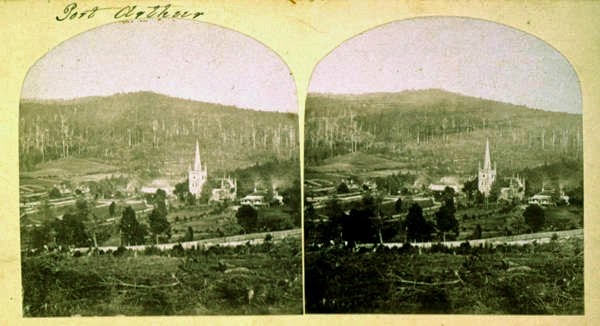
State Library of Tasmania
Ref:AUTAS001124851726
Other photographs in public collections bearing Bock and Nevin's stamp for The City Photographic Establishment and attributed to Alfred Bock include this one of the Officers' Cricket Team at Port Arthur, taken no doubt at the behest of the officers who requested a portrait of James Boyd ca 1864:
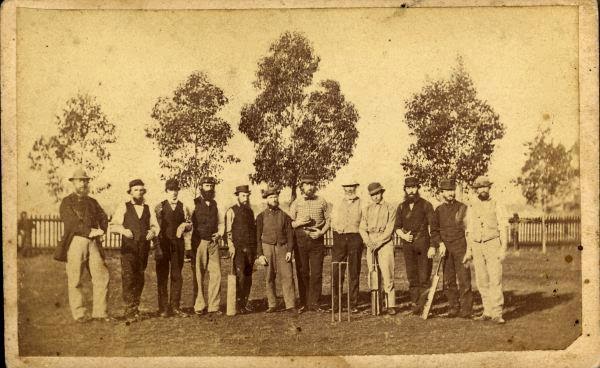
State Library of Tasmania
Title: Officers at Port Arthur Cricket Team
Creator(s):Bock, Alfred, 1835-1920
Date: Between 1858 and 1867
Description: 1 photograph mounted on board : sepia toned ; 7 x 10 cm.
Notes: Exact measurements of image: 58 x 95 mm., Title derived from note inscribed in pencil on verso by unknown hand., Alfred Bock's trademark for his studio at 140 Elizabeth St. Hobart on verso.
Location: Allport Library and Museum of Fine Arts
ADRI: AUTAS001126187517
This photograph of twelve guards at Port Arthur is also attributed to Alfred Bock, although the TAHO catalogue note does not state that it bears verso Bock's studio stamp:
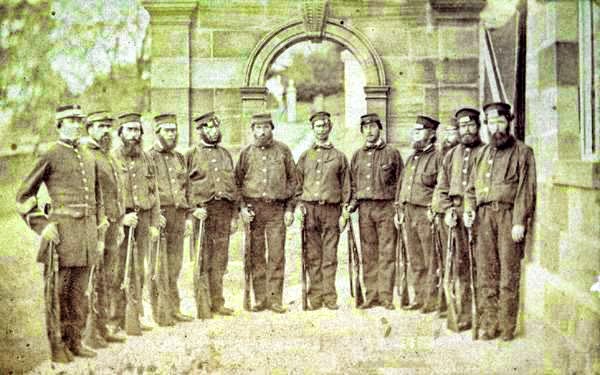
TAHO:
Title: Port Arthur, Guards c.1866
Publisher: Hobart : Alfred Bock, ca. 1866
Description: 1 photographic print on card : sepia toning ; 62 X 100 mm
Format: Photograph
Source: Allport Library and Museum of Fine Arts
Notes: Title inscribed in pencil on verso
A short history is included on this site of Alfred Bock's career in Tasmania to his insolvency in August 1865 when Nevin then continued at the studio and put the business in his own name.







